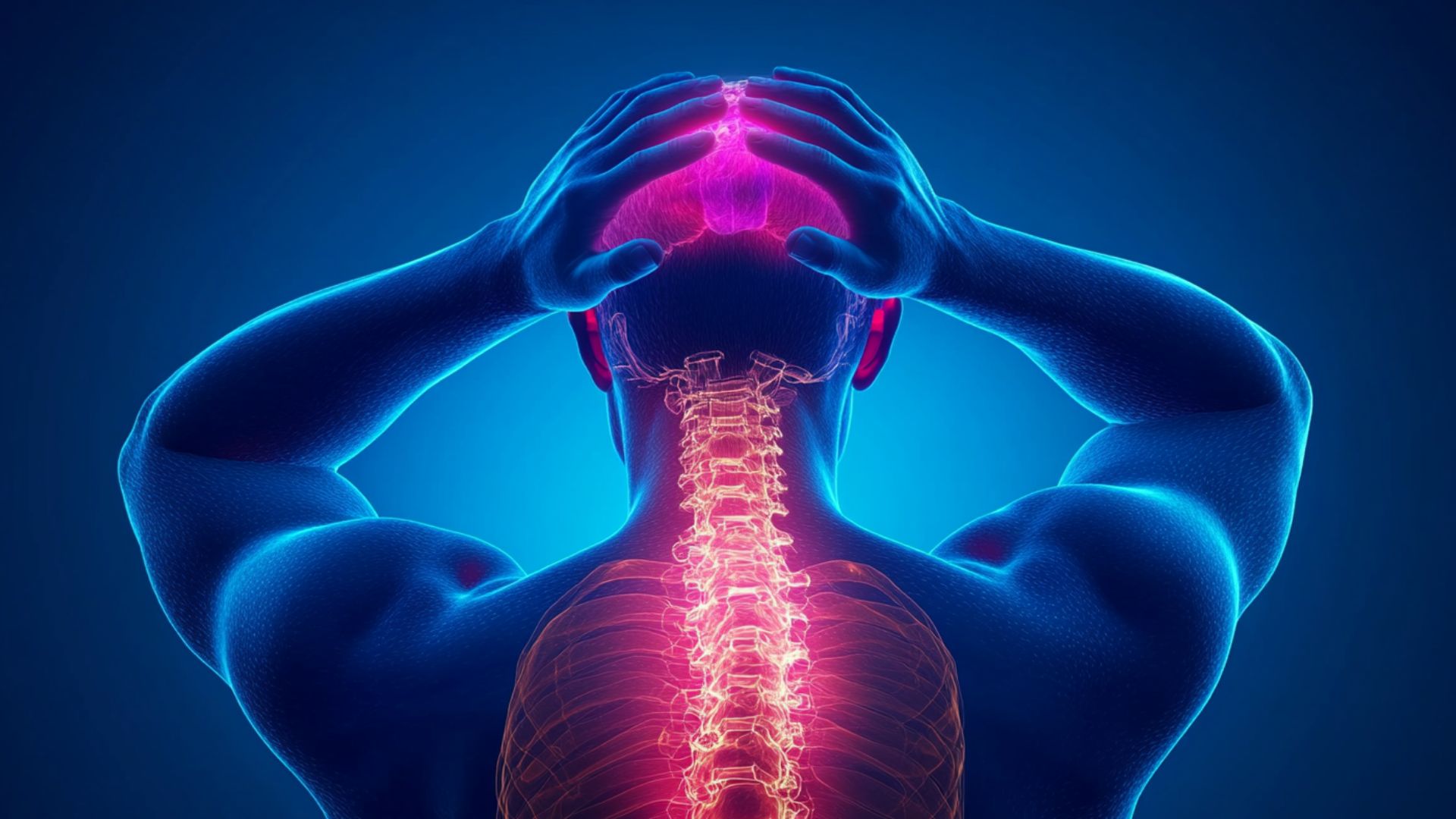Some patients experience partial migraines or headaches that they may attribute to weather sensitivity, increased workload, or general fatigue that builds up over long days without rest. Without treatment, the problem can worsen significantly. Patients typically report that the pain begins on one side of the neck or at the base of the skull and spreads through the parietal and temporal regions to the forehead and the eye. This is often described as a “helmet-like” headache or feeling like you’re trying to remove a tight helmet.
Occipital neuralgia differs from regular headaches. Common triggers include tight neck muscles and poor posture. Many individuals experience old whiplash injuries or arthritis in the upper neck. Because the pain mimics migraines or cluster headaches, it’s frequently misdiagnosed. Getting an early, correct diagnosis from a neurologist makes a significant difference. Most people respond well to simple treatments. The most effective treatments include medications and posture adjustments, allowing patients to regain their quality of life quickly.
Understanding Occipital Neuralgia and Its Connection to Neck Pain
Occipital neuralgia is caused by compression or inflammation of the nerves that run from the upper neck to the scalp. Irritation triggers sharp, shooting, or burning pain from the neck to the head, often worsened by movement or poor posture. Tight muscles, joint issues, or instability increase nerve pressure. When these nerves are compressed, the pain can radiate upward and may feel like a severe headache originating from the cervical spine.
Here are the key factors:
- Neck tension: Tight muscles around the upper cervical spine compress the occipital nerves. This tension often develops from stress and can cause significant discomfort. Repetitive movements, such as prolonged screen use, may also contribute to this tension.
- Poor posture increases cervical strain: Slouching or leaning forward places extra pressure on the neck. Over time, this strain contributes to nerve irritation and persistent discomfort.
- Inflammation triggers nerve pain: Individuals experience swelling from injury or joint irritation. These conditions can inflame the tissues surrounding the nerves. This inflammation causes sharp or burning pain.
- Cervical spine dysfunction: It sends pain signals to the head. Misaligned joints or restricted movement in the upper spine disrupt normal nerve pathways. This disruption leads to radiating pain that feels like a cervicogenic headache.
Understanding these differences is essential for proper treatment. Early evaluation by a neurologist or spine specialist improves outcomes. Targeted therapies, posture correction, nerve blocks, and physical therapy can significantly reduce symptoms. With proper care, most individuals experience lasting relief and improved quality of life.
Common Occipital Neuralgia Symptoms You Shouldn’t Ignore
If neck pain suddenly turns into an ice-pick stab that shoots to the back of your head, you may be experiencing occipital neuralgia symptoms. These aren’t your everyday headaches — they feel dramatically different.
Here are the hallmark signs of occipital neuralgia:
- Electric shock or stabbing pain: This sharp sensation usually begins at the base of the skull. It can shoot forward behind one or both eyes and feels sudden and intense.
- Scalp tenderness: Even gentle contact can be painful. Brushing your hair or resting your head on a pillow may increase sensitivity.
- Burning or throbbing pain: This often follows the nerve’s path on one side of the head. It can feel warm, aching, or pulsating.
- Light sensitivity: Bright light can feel overwhelming. This happens especially when neck stiffness worsens the discomfort.
Migraines often throb and build gradually, typically accompanied by nausea and other symptoms. Occipital neuralgia symptoms create sharp, shooting discomfort. While tension headaches feel like a tight band around the head, occipital neuralgia strikes suddenly. It feels like a lightning bolt directly tied to your neck position. The pain can mimic a migraine, but it almost always starts in the upper neck and radiates upward. Don’t brush it off as “just another headache.”
Diagnosing Occipital Neuralgia: What to Expect From Your Neurologist
Getting a precise diagnosis is essential when dealing with persistent head and neck pain. Occipital neuralgia can resemble migraines, tension headaches, and cervical spine problems. Neurologists use a structured approach to pinpoint the exact cause. The goal is to identify nerve irritation and rule out other conditions. It’s also essential for choosing the most effective occipital neuralgia treatment plan.
Here’s what typically happens during your visit:
- Detailed history: Your doctor asks exactly where the pain starts, what makes it worse (such as neck position, touch, or movement), and whether it’s one-sided or shoots behind the eyes.
- Diagnostic nerve block: The gold standard for diagnosis. A small injection of local anesthetic is given near the occipital nerve. If your pain vanishes within minutes, occipital neuralgia is almost certainly confirmed.
- Palpation of the occipital nerves: Gentle pressure over the greater occipital nerve (just below the skull) often reproduces your exact pain. This is a classic diagnostic sign.
- Imaging when needed: MRI or CT of the brain and cervical spine may be ordered to exclude tumors and identify conditions such as Chiari malformation, cervical disc herniation, or arthritis that can compress the nerves.
These steps help distinguish occipital neuralgia from migraines, cluster headaches, cervicogenic headaches, and more serious conditions. A positive response to an occipital nerve block is so specific that many patients leave the office with both a diagnosis and immediate relief. Accurate diagnosis means targeted treatment and an end to guessing why your neck keeps triggering unbearable head pain.
Occipital Neuralgia Treatment Options: From Pain Relief to Long-Term Management
Occipital neuralgia doesn’t have to mean surgery or lifelong medication. Most people get excellent relief, and many become pain-free with a stepped approach that starts gently and intensifies only if needed. Doctors usually begin with simple, at-home steps and move up only when necessary.
Here’s the typical progression of occipital neuralgia treatment:
- Conservative first-line care: Rest and apply warm or cold packs to the neck. Perform gentle neck stretches and correct your posture. This is especially important for correcting forward-head posture from phone or desk use.
- Occipital nerve blocks: It is a quick office procedure. A local anesthetic with or without a steroid is injected around the greater or lesser occipital nerve. Pain often disappears within minutes. This confirms the diagnosis and provides weeks to months of relief.
- Physical therapy: Targeted exercises strengthen deep neck muscles, improve posture, and reduce pressure on nerves. These exercises are often key to preventing flare-ups.
The earlier you start treatment for occipital neuralgia, the faster the cycle breaks. Many patients feel dramatic improvement after their first occipital nerve block or a few weeks of physical therapy. Waiting too long allows the nerves to stay irritated, potentially turning an easily fixable problem into chronic pain. See a neurologist or pain specialist at the first sign of recurring electric jolts in the neck. Your future, headache-free self will thank you.
Advanced and Minimally Invasive Therapies for Severe Cases
When first- and second-line treatments fail, occipital neuralgia can still be controlled with advanced options. These are reserved for persistent, life-disrupting pain that no longer responds to occipital nerve blocks, medications, or physical therapy. Neurologists choose the next step based on your response to prior treatments, imaging findings, and the extent to which the pain affects your daily life.
Here are the main advanced therapies:
- Botox injections: Injected near the occipital nerves every 3 months. Reduces nerve irritation and muscle spasms. Relief lasts 8-12 weeks. Success rate: 60-80%. No downtime required.
- Occipital nerve stimulation (ONS): An electrode placed at the skull base sends mild pulses to block pain signals. Trial period of 7-14 days; permanent implant if ≥50% pain relief achieved. Recovery takes 1-2 weeks. Success rate: 70-85%. Lifelong follow-up required.
- Surgical decompression: Microsurgery relieves nerve compression from bone or muscle. Recovery takes 4-6 weeks. Long-term success rate is approximately 80%.
Every case is different. Your neurologist reviews your past response to occipital nerve blocks and imaging results before recommending any advanced therapy. Pain specialists or neurosurgeons perform these procedures and always include ongoing supervision. Even severe occipital neuralgia can become manageable or disappear altogether with the right treatment approach.
Preventing Occipital Neuralgia and Managing Neck Health
Preventing occipital neuralgia begins with proper care of your neck and spine. Simple lifestyle changes can reduce nerve irritation and lower the risk of developing chronic pain. Consistent habits support long-term neck health and overall well-being. Here are the key prevention strategies:
- Ergonomic work setups: Keep screens at eye level and use supportive chairs to reduce neck strain.
- Posture awareness: Maintain a neutral spine while sitting, standing, and walking.
- Neck stretches: Gentle stretches relieve tension and improve flexibility.
- Hydration: Proper fluid intake supports muscle and nerve function.
- Movement breaks: Stand, stretch, or walk every 30-60 minutes during long periods of sitting.
- Neck strengthening exercises: Light resistance exercises improve support for the cervical spine. These exercises also help prevent nerve compression.
Early evaluation is essential. If sharp neck-to-head pain appears, consult a neurologist promptly. Timely intervention ensures accurate diagnosis and effective occipital neuralgia treatment while preventing complications. Proper diagnosis and lifestyle adjustments are crucial. Modern therapies help most patients experience lasting relief from occipital neuralgia symptoms. Regular care and preventive measures help maintain neck function. These measures reduce pain flare-ups and improve quality of life. Contact experts at Lone Star Neurology for accurate diagnosis and fast relief.











Please, leave your review
Write a comment: